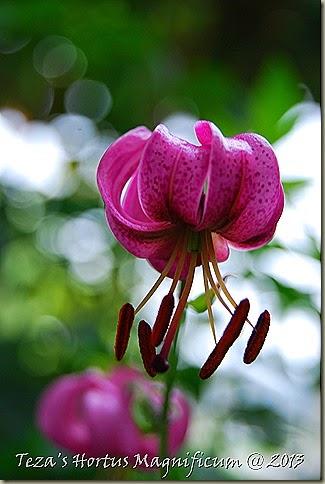
It’s been used to kill marauding packs of wolves throughout Europe, hence the name ‘Wolfsbane’, and is also known as ‘Monkshood,’ perhaps for the distinctive shape of the blue flowering species. Aconitum, its proper botanical nomenclature refers to the ancient name used by Theophrastus when describing a poison herb. All parts of this beautiful plant are poisonous when ingested, yet A. napellus, the classic European species, as served as a source of aconite, a heart sedative. With this tidbit of information, one can guess the response its presence elicits when discovered growing most abundantly within my garden repertoire! ‘Tell me that’s not monkshood you having growing there, is it? Surely you know its poisonous, all of it, not just the flowers!’ Funny how they walked past and actually reached out to touch the drooping bell shaped flowers of a neighboring Digitalis. Hate to be the harbinger of bad news, but its poisonous too! A modicum of safety is definitely called for, hence, I wouldn’t prescribe it as a possible selection for a garden where young children or pets might have access, but at the same time, the idea of irradiating it entirely, based purely on its toxicity, considering there are many other equally toxic plants in existence – it all seems a wee bit hysterical to me!

I grow both blue-purple flowered species, as well as the creamy white and yellow ones as well. I remain smitten with the native trailing species, A. uncinatum, pictured above, whose long, trailing stems can reach 2m in length, which I have learned through trial and error, look best when allowed to twist and curl through a small sized obelisk. It’s purple, inflated helmet shaped flowers appear in dense racemes at the leaf axils, and put forth a floriferous display from late July well into August.
I am partial to the white through butter yellow species, only because for me, they tend to be more reliable in my partly shaded garden setting. Aconitum ‘Ivorine’ [pictured below] is the earliest of my collection to bloom, and when you combine its wonderful mounding, somewhat lacy blue green foliage with its pristine white flowers that are often suffused with creamy green at their tips, you have perfection personified! And about those flowers! Some have joking referred to them as resembling ‘smurf’ caps, while I refer to them as resembling the mitre worn by the Pope! If happy, Miss Ivorine will delightfully seed about the partially shaded border!
 The other two species that I grow are A. lycoctanum and A. kyrlovii, both similar in stature with A. kyrlovii blooming later in the season. I love their shorter stature, which combined with a truly magnificent large palmate leaf, makes for a most striking mid border presentation. Its photo can be seen at the beginning of this post. I have tried some of the taller, more statuesque garden varieties, but have found them to be highly susceptible to crown and root rot and have removed all but one from the garden.
The other two species that I grow are A. lycoctanum and A. kyrlovii, both similar in stature with A. kyrlovii blooming later in the season. I love their shorter stature, which combined with a truly magnificent large palmate leaf, makes for a most striking mid border presentation. Its photo can be seen at the beginning of this post. I have tried some of the taller, more statuesque garden varieties, but have found them to be highly susceptible to crown and root rot and have removed all but one from the garden. Aconitum demand soil that is high in organic content, [they are heavy feeders], loose and free-draining. It is all but futile to plant them in heavy, clayish, waterlogged soils. Most will grow in full sun, but I have found, especially with the lighter flowering species, that morning and late afternoon sun work best! It is also worth noting that since most species are native to the northern temperate regions of North America and Eurasia, that most dislike the warmer temperatures of the southern temperate zones and are not suitable where nightly temperatures exceed 21 degrees Celsius. Most species are hardy between Zones 3-6, unless otherwise stated. While there is definite caution when considering these alluring specimens, I could not call my garden complete without their inclusion!
Aconitum demand soil that is high in organic content, [they are heavy feeders], loose and free-draining. It is all but futile to plant them in heavy, clayish, waterlogged soils. Most will grow in full sun, but I have found, especially with the lighter flowering species, that morning and late afternoon sun work best! It is also worth noting that since most species are native to the northern temperate regions of North America and Eurasia, that most dislike the warmer temperatures of the southern temperate zones and are not suitable where nightly temperatures exceed 21 degrees Celsius. Most species are hardy between Zones 3-6, unless otherwise stated. While there is definite caution when considering these alluring specimens, I could not call my garden complete without their inclusion! 
[A. Ivorine interplanted with Baptisia ‘Purple Smoke’]
 [Aconitum lycoctanum: A floriferous mid-summer bloomer!]
[Aconitum lycoctanum: A floriferous mid-summer bloomer!]
































3 comments:
For many years, a favorite of mine too.
And besides, how many of us are stupid enough to eat our plants? These plants are just delicious--I mean, delightful.
I am with you on this--I've had aconitum in my garden since digging it up from an abandoned homestead down the road, 12 years ago...and have never had any problems with it, either for humans or pets. Common sense trumps hysteria, or it should. There are all kinds of toxic plants in the garden, and many people are clueless about them--or else they overreact as was your experience.
My current favourite is 'Cloudy', although I'm also very fond of 'Stainless Steel' and the 'red' species.
Post a Comment